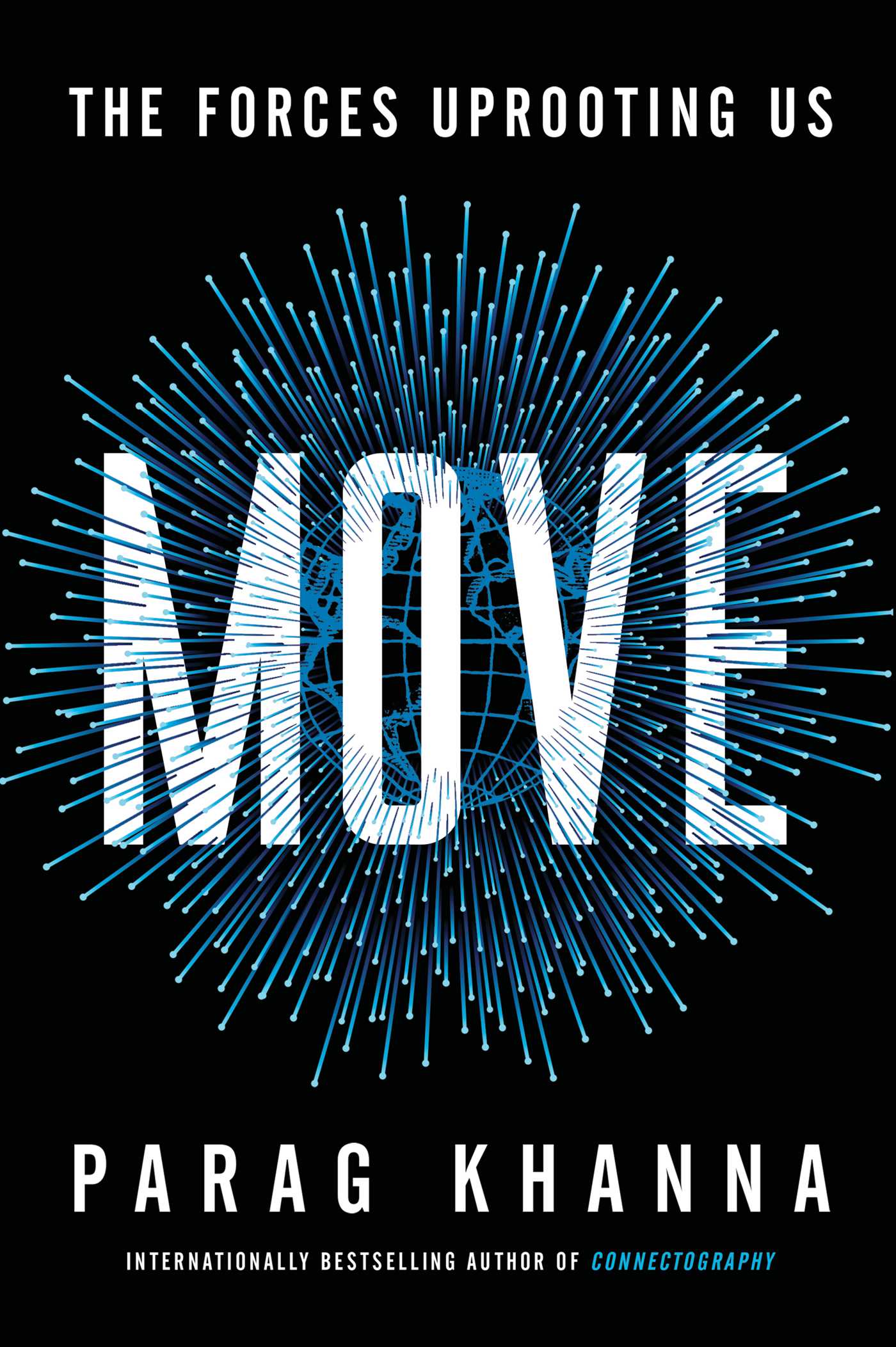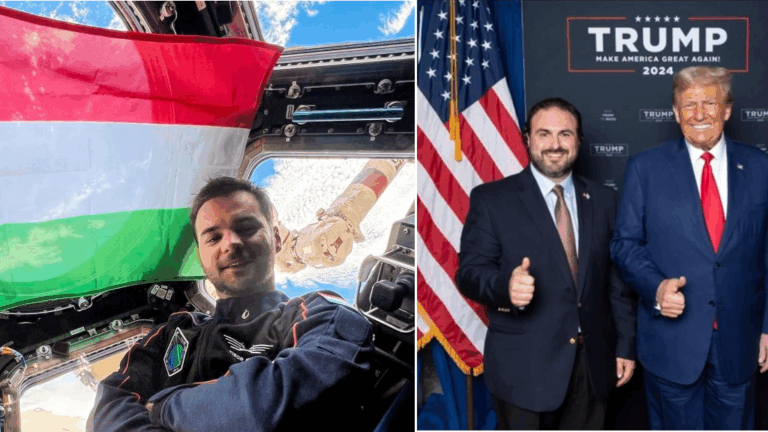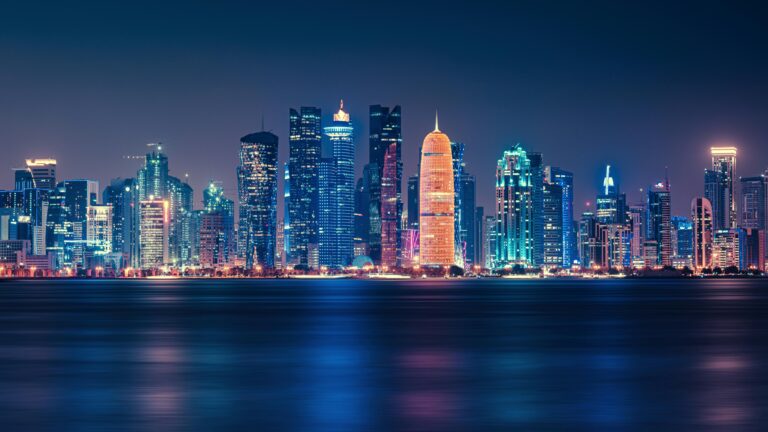A Review of Parag Khanna’s Move
Move: The Forces Uprooting Us, the latest work by the internationally best-selling author of Connectography, provides an interesting perspective on today’s challenges, and shows us how all of our problems are interconnected. Parag Khanna is a world-renowned global strategy adviser, specializing in geopolitics and globalization. In this book, published by Scribner at the end of 2021, Khanna connects the various issues weighing on our minds at the beginning of the twenty-first century: climate change, global warming, water stress, and mass migration. And to the question ‘where will we live in 2050?’ the book offers a possible answer.
The thesis of the volume is the following: ‘To move and to build—this is the essence of being human.’1 As long as we are ready to move it does not matter where we live, what matters is our ability to adapt to our changing environment. Future generations will join the ten-thousand- year tradition of humankind: move. Even though Khanna considers migration to be the only solution to the challenges of our day, this may not be the case. Experience shows that there are in fact other ways to counter both demographic discrepancies and climate disasters.
The best and most often employed means of coping with a dangerous increase in complexity is to move
Khanna’s recently published Move can be seen as a controversial work. His basic thesis is that to move is a natural instinct that arises in us every time we encounter a challenge we consider insurmountable. Khanna also gives a historical overview in order to back up his argument, saying that it is the natural behaviour of humankind to escape from impossible situations that are not worth fighting. The world is complex and it is getting more so. The best and most often employed means of coping with a dangerous increase in complexity is to move. But where to? To find the answer we have to apply a holistic framework that gives equal weight to political, economic, social, technological, and environmental factors.
It was probably the COVID-19 pandemic that served as an inspiration for this book: Khanna tells us how he was confounded by the unnatural situation brought about by the Great Lockdown in Spring 2020, when everything stood still, not only people but also all the infrastructure that had been continually constructed and developed over the centuries to ensure that human mobility is undisturbed.
As Khanna puts it, ‘The map of humanity isn’t settled—not now, not ever’.2 This is why human geography should be pushed to the centre of our interests, because it investigates the distribution of our species across six continents. ‘Where will you live in 2050?’3 is a question most people would like to know the answer to. Probably north of where you currently live, since the ‘GreatMigration’ of our age is defined by movement from south to north. Why? Simply because climate change will make most of the Global South uninhabitable, while large, uninhabited northern areas will become fit for our needs, and will require a large workforce.
Today people are not equally distributed on and among the continents: it seems that the population living in relatively poor areas of the world near the Equator is growing with unprecedented speed, while northern societies sitting on huge stocks of wealth and resources are experiencing a demographic decline. Maybe Asia is the exception to this rule, as on this continent the demographic boost was matched by the progress of the economy, which for now seems sufficient to retain its population, but it appears unlikely to stop them from moving towards Europe and North America for much longer. They have both the means and the opportunities to migrate towards better living conditions, where the air is cleaner and the streets are less crowded, while the masses stuck in Africa simply keep on circulating inside their own continent, unable to improve their living conditions.
The settled lifestyle is merely an exception, as history shows that to move is the natural state of affairs. As a consequence of global warming and the melting of the ice caps, it will be those who are ready to move and to adapt to a new environment that are most likely to survive. In addition to rising sea levels, the other water-related problem, the lack of potable water, will turn this resource into the blue gold of our age. While rising sea will destroy highly developed areas such as New York, Los Angeles, and London, water stress will cause further ordeals to relatively poor societies where the population is already suffering from war and hunger. As the unsustainable settled way of life disintegrates, the era of the so-called ‘quantum people’4 will emerge. These are the young people who do not hesitate to make a living from remote working, which became so ubiquitous during the Great Lockdown. They are ready to change their locations as flexibly as the seasons change—somewhat like migrating species. They might even become digital nomads, a group that will adapt best to the changing and unpredictable environment. The quantum people phenomenon fits into the framework that is best described by the increasing tide of ‘disurbanization’. Today’s youth in the developed world prefer to leave crawling city centres and settle down in smaller cities or even towns with cleaner air, less heavy traffic, and green playgrounds with affordable childcare for their offspring.
As a consequence of global warming and the melting of the ice caps, it will be those who are ready to move and to adapt to a new environment that are most likely to survive
We must nonetheless bear in mind that according to their means and motivations, people adapt to new situations differently in different parts of the world. The USA has seen a rise in the number of people selling their real estate and opting for the more affordable—and certainly more mobile— option of campers, trucks, and school buses turned into homes. And even those who are not yet ready for such a radical change are leaving the overpriced and increasingly unsafe metropolises behind and moving to the Midwest and the Great Lakes region. As for Europe, the book’s prognosis foresees that many regions will become abandoned as heat waves, floods, and heavy precipitation render life much more unpleasant than Europeans can bear. And where are the best places to settle permanently? Khanna suggests Canada, Russia, and Scandinavia, based less on socio-political than on environmental considerations. Furthermore, there are also individual cities, located more often than not in very unfavourable areas where people manage to counter the effects of global warming by spending an enormous amount on desalination, air conditioning—and immigration. The best practices are provided by Singapore and Abu Dhabi, and many more cities are trying to adopt their policies to support sustainable development. By acting together, they might counteract the effects of huge, polluting superstates. In Khanna’s vison: ‘The future could be defined by a progressive new peace among small states and cities: a Pax Urbanica.’5

In a world with so much talented and mobile youth, the future will witness a war for talent. Generations differ in lifestyles and mindset, and obviously make different decisions as their different historical experiences determine their choices. While for baby boomers and Generation X the motto was ‘geography is destiny’, for Millennials and Generation Z it is ‘demography is destiny’.6 But today a new axiom is emerging, namely, ‘mobility is destiny’. On this basis, the author believes that mass migration is inevitable, as it will be the elemental force draining overpopulation in response to ever more aggressive climate change. True enough, both phenomena are hitting the Global South considerably harder than the rest of the planet.
The narrative of the book suggests that the settled way of life was only the privilege of a few generations in a marginal number of locations on the face of the Earth. Both tourism and migration peaked in 2019, the year before the pandemic. While there are some countries that are trying to stop the immense flow of immigrants and refugees, others are utterly dependent on it. Khanna believes that nations are only temporary constellations that were constructed once and can be deconstructed with time. As a consequence, nations are nothing but imagined communities.7 But our nations and the ideas they were built on seem to us to be values worth upholding. It might be so for every single civilization, so when people with different backgrounds and history settle down elsewhere, they may trigger a clash of civilizations.8
Today’s global system is built on the existence of sovereign nations that exercise authority over their territories and populations. To allow people to be constantly on the move would upset the entire global system, and the outcome is at the very least uncertain. Besides, our perception of foreigners is based on historical lessons: while in some countries immigration helped strengthen a society, in others it seems to be disrupting it. Khanna argues that efficient assimilation schemes are needed to absorb the newcomers, but he forgets that in Europe assimilation has ominous connotations, which is why governments are trying to avoid it at any cost. Instead, Europe has been advertising itself as the cradle and protector of human rights, and has hoped that this alone would inspire immigrants to accept our ways of life. Unfortunately, there are negative examples in which cultural differences have prevented the peaceful co-existence of groups not sharing the same historical identity.
It is nonetheless true that the Global North, and especially Europe and North America, are facing the prospect of shrinking populations that might trigger a crisis situation in the upcoming decades, as there will not be enough active workers on the labour market to provide social welfare for the elderly and the children. However, in my view, there are other possible ways to counter these negative trends. Some European countries, and Hungary is a trailblazer in this regard, have decided to find another solution to remedy the demographic crisis. Hungary is focusing on family policies rather than on immigration. Governmental incentives and schemes have been created in this spirit, in order to allow newlyweds and young families to have more children, and to bring them up in as favourable conditions as possible.
‘Geopolitically, the world seems like it’s turning yellow, but demographically it’s unquestionably turning brown.’
In the early twenty-first century, it is East Asian powers that are increasingly amassing the global economic wealth and the political power, while on the Indian subcontinent the population is growing at a steadily accelerating pace. In these countries, young, educated, middle-class Millennials are eager to move, especially those disappointed by the opportunities offered by their home country. ‘Geopolitically, the world seems like it’s turning yellow, but demographically it’s unquestionably turning brown.’9 The author of the book is himself from an immigrant family from India, who was well received in countries such as the United Arab Emirates and the United States, at a time when immigration was both encouraged and supported there. He praises assimilation policies and changing residences. He claims that younger generations no longer wish to grow old in one place, or to have a large number of children who destroy the environment, or to preserve the way of life they knew as children. However, I am not sure that others from different backgrounds and experiences would agree. Controversial? Perhaps.
To all the controversies listed in the book, the author offers a frame, a timeline, where readers can allocate his arguments: ‘Much more than a shift from one place to another, we must evolve from one model of civilization to another. Civilization 1.0 was nomadic and agricultural: The world population was small and localized, and the environment dictated where we could survive. Then came Civilization 2.0, in which we became sedentary and industrial. We settled in ever larger cities and commoditized nature through global supply chains. The negative feedback loop between man and nature is killing us both. Now we must adapt again. Civilization 3.0 will need to be mobile and sustainable: We will move inland toward higher elevation and into our vast northern expanses.’10 The motto of Civilization 3.0 should be, as Khanna phrases it, ‘cosmopolitan utilitarianism’11. Whether we are already living in Civilization 3.0 or we are merely on the brink of it in 2022 is an open question. The answer can only be deciphered by connecting the dots in our ever-changing reality.
NOTES
1 Parag Khanna, Move: The Forces Uprooting Us (New York: Scribner, 2021), 19.
2 Khanna, Move, 9.
3 Khanna, Move, 7.
4 Khanna, Move, 211.
5 Khanna, Move, 229.
6 Khanna, Move, 12.
7 Benedict Anderson, Imagined Communities: Reflections on the Origin and Spread of Nationalism (London: Verso, 1983).
8 Samuel Huntington, The Clash of Civilizations and the Remaking of the World Order (New York: Simon and Schuster, 1996).
9 Khanna, Move, 25.
10 Khanna, Move, 252.
11 Khanna, Move, 260.








